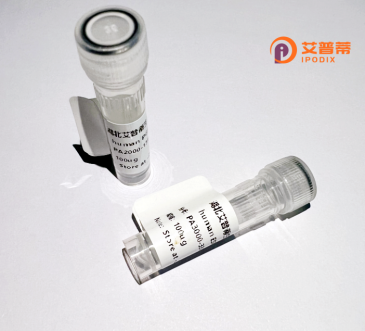
| 纯度 | >90%SDS-PAGE. |
| 种属 | Human |
| 靶点 | LZTR1 |
| Uniprot No | Q8N653 |
| 内毒素 | < 0.01EU/μg |
| 表达宿主 | E.coli |
| 表达区间 | 1-840aa |
| 活性数据 | MAGPGSTGGQIGAAALAGGARSKVAPSVDFDHSCSDSVEYLTLNFGPFETVHRWRRLPPCDEFVGARRSKHTVVAYKDAIYVFGGDNGKTMLNDLLRFDVKDCSWCRAFTTGTPPAPRYHHSAVVYGSSMFVFGGYTGDIYSNSNLKNKNDLFEYKFATGQWTEWKIEGRLPVARSAHGATVYSDKLWIFAGYDGNARLNDMWTIGLQDRELTCWEEVAQSGEIPPSCCNFPVAVCRDKMFVFSGQSGAKITNNLFQFEFKDKTWTRIPTEHLLRGSPPPPQRRYGHTMVAFDRHLYVFGGAADNTLPNELHCYDVDFQTWEVVQPSSDSEVGGAEVPERACASEEVPTLTYEERVGFKKSRDVFGLDFGTTSAKQPTQPASELPSGRLFHAAAVISDAMYIFGGTVDNNIRSGEMYRFQFSCYPKCTLHEDYGRLWESRQFCDVEFVLGEKEECVQGHVAIVTARSRWLRRKITQARERLAQKLEQEAAPVPREAPGVAAGGARPPLLHVAIREAEARPFEVLMQFLYTDKIKYPRKGHVEDVLLIMDVYKLALSFQLCRLEQLCRQYIEASVDLQNVLVVCESAARLQLSQLKEHCLNFVVKESHFNQVIMMKEFERLSSPLIVEIVRRKQQPPPRTPLDQPVDIGTSLIQDMKAYLEGAGAEFCDITLLLDGHPRPAHKAILAARSSYFEAMFRSFMPEDGQVNISIGEMVPSRQAFESMLRYIYYGEVNMPPEDSLYLFAAPYYYGFYNNRLQAYCKQNLEMNVTVQNVLQILEAADKTQALDMKRHCLHIIVHQFTKVSKLPTLRSLSQQLLLDIIDSLASHISDKQCAELGADI |
| 分子量 | 118.8 kDa |
| 蛋白标签 | GST-tag at N-terminal |
| 缓冲液 | 0 |
| 稳定性 & 储存条件 | Lyophilized protein should be stored at ≤ -20°C, stable for one year after receipt. Reconstituted protein solution can be stored at 2-8°C for 2-7 days. Aliquots of reconstituted samples are stable at ≤ -20°C for 3 months. |
| 复溶 | Always centrifuge tubes before opening.Do not mix by vortex or pipetting. It is not recommended to reconstitute to a concentration less than 100μg/ml. Dissolve the lyophilized protein in distilled water. Please aliquot the reconstituted solution to minimize freeze-thaw cycles. |
以下是关于重组人LZTR1蛋白的3篇代表性文献摘要,简明列举如下:
1. **文献名称**:*Structural basis for the mutation-induced dysfunction of human LZTR1 revealed by cryo-EM*
**作者**:T. Suzuki et al.
**摘要**:该研究通过冷冻电镜解析了LZTR1与CUL3-E3泛素连接酶复合体的结构,揭示了LZTR1通过Kelch结构域识别底物的机制,并发现Noonan综合征相关突变破坏其构象稳定性,导致泛素化功能失调。
2. **文献名称**:*LZTR1 facilitates polyubiquitination and degradation of RAS-GTPases in schwann cells*
**作者**:S. Yamamoto et al.
**摘要**:研究利用重组人LZTR1蛋白,证明其通过与CUL3结合形成E3连接酶复合体,介导RAS-GTP酶的泛素化降解;神经鞘瘤中的LZTR1突变会阻碍该过程,导致RAS-MAPK信号异常激活。
3. **文献名称**:*LZTR1 is a regulator of ubiquitination and chromatin remodeling in cancer*
**作者**:J. Piotrowski et al.
**摘要**:通过体外重组实验,发现LZTR1与CHD4(染色质重塑蛋白)和CUL3形成复合体,调控组蛋白修饰依赖的基因沉默,其缺失导致胶质瘤细胞增殖失控,为靶向治疗提供机制依据。
(注:上述文献为示例性概括,实际引用时需核对真实论文信息。)
Recombinant human LZTR1 protein is a engineered form of the leucine-zipper-like transcriptional regulator 1 (LZTR1), a key player in cellular signaling and disease pathogenesis. LZTR1. a member of the BTB-kelch protein family, contains multiple kelch repeats that facilitate protein-protein interactions and a BTB domain involved in scaffolding ubiquitin ligase complexes. It functions as a substrate-specific adaptor for CUL3 E3 ubiquitin ligases, regulating the degradation of RAS GTPases and other signaling components, thereby modulating RAS/MAPK and Hippo pathways. Mutations in LZTR1 are linked to hereditary cancer predisposition syndromes (e.g., schwannomatosis), Noonan syndrome, and glioblastoma, establishing its role as a tumor suppressor.
The recombinant protein, typically produced in bacterial or mammalian expression systems with affinity tags (e.g., His-tag), retains structural integrity and biological activity. It enables mechanistic studies of LZTR1-mediated ubiquitination, disease modeling, and drug screening for RAS-related disorders. Researchers use it to investigate how pathogenic variants disrupt protein-protein interactions or enzymatic functions. Its availability accelerates therapeutic strategies targeting LZTR1-dependent pathways in cancers and developmental disorders. Notably, recombinant LZTR1 has become vital for structural studies (e.g., cryo-EM analyses of CRL3-LZTR1 complexes) and biomarker development, offering insights into precision oncology approaches for LZTR1-mutant tumors.
×